University Report: Business Intelligence and Big Data Strategies
VerifiedAdded on 2020/02/24
|18
|3868
|41
Report
AI Summary
This report examines the application of big data in business intelligence, emphasizing its role in enhancing decision-making and creating new business models. It discusses various strategies for leveraging big data, including aligning with business problems and market opportunities, and the importance of business initiatives and objectives. The report delves into the technology stack, particularly Hadoop Distributed File System (HDFS), and the use of data analytics and multidimensional data analysis (MDM) to support data science and business intelligence. It highlights the role of NoSQL databases in big data analytics, exploring different types such as key-value stores, document stores, column stores, and graph databases. The influence of social media and human elements in decision-making is also considered, along with the big data value creation process. The report concludes with recommendations for leveraging big data effectively, offering valuable insights for organizations seeking to gain a competitive advantage in the market. It covers various aspects of data warehousing and its evolution to become operational in nature.
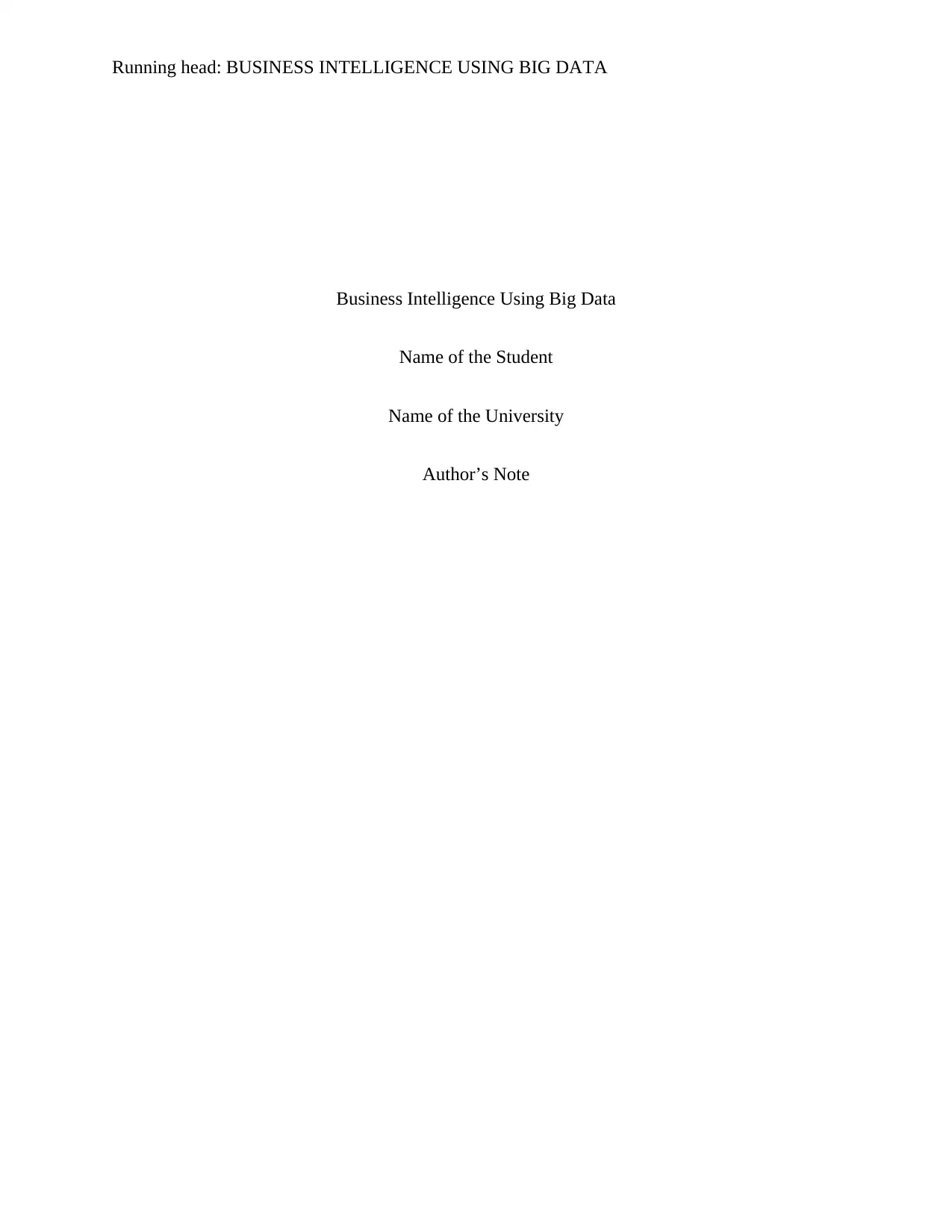
Running head: BUSINESS INTELLIGENCE USING BIG DATA
Business Intelligence Using Big Data
Name of the Student
Name of the University
Author’s Note
Business Intelligence Using Big Data
Name of the Student
Name of the University
Author’s Note
Paraphrase This Document
Need a fresh take? Get an instant paraphrase of this document with our AI Paraphraser
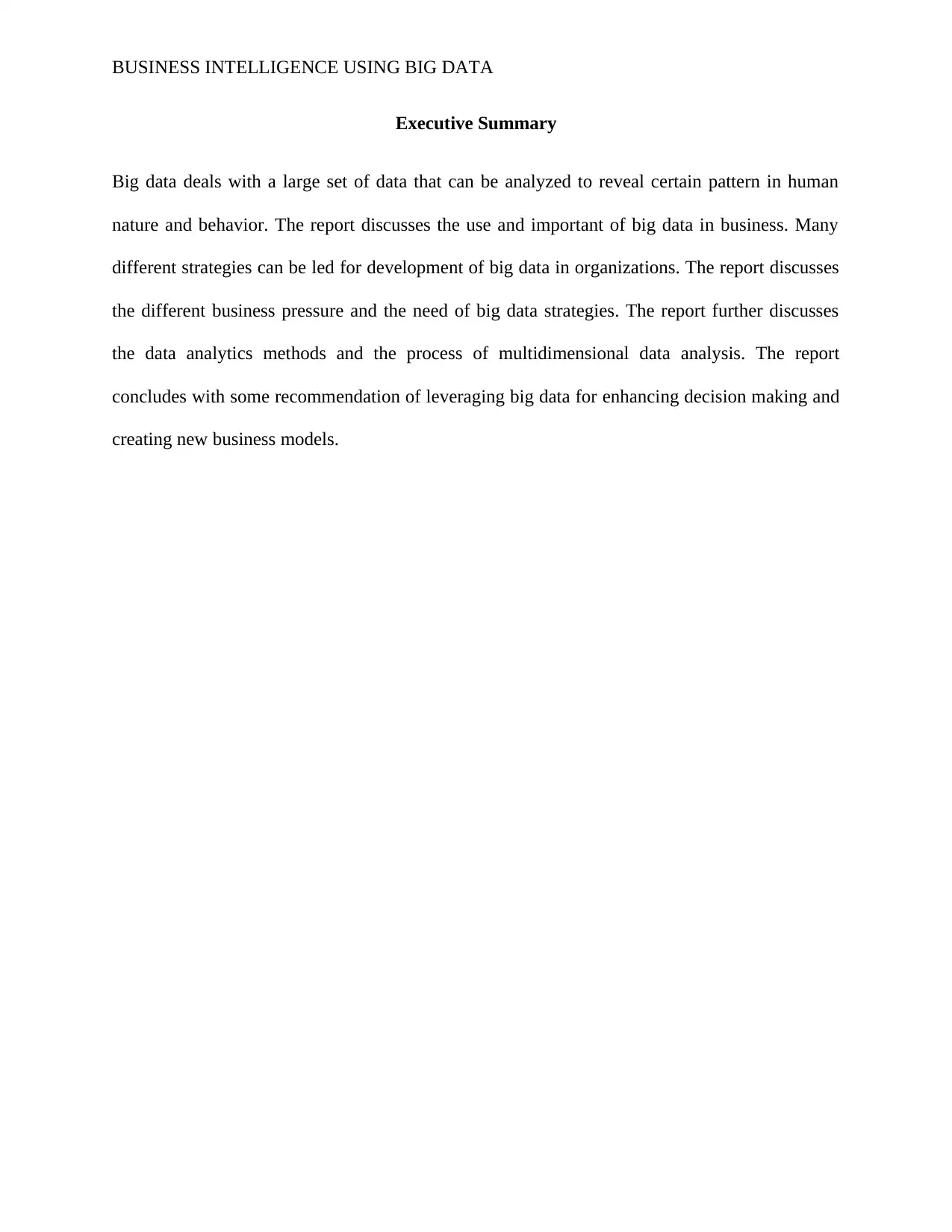
BUSINESS INTELLIGENCE USING BIG DATA
Executive Summary
Big data deals with a large set of data that can be analyzed to reveal certain pattern in human
nature and behavior. The report discusses the use and important of big data in business. Many
different strategies can be led for development of big data in organizations. The report discusses
the different business pressure and the need of big data strategies. The report further discusses
the data analytics methods and the process of multidimensional data analysis. The report
concludes with some recommendation of leveraging big data for enhancing decision making and
creating new business models.
Executive Summary
Big data deals with a large set of data that can be analyzed to reveal certain pattern in human
nature and behavior. The report discusses the use and important of big data in business. Many
different strategies can be led for development of big data in organizations. The report discusses
the different business pressure and the need of big data strategies. The report further discusses
the data analytics methods and the process of multidimensional data analysis. The report
concludes with some recommendation of leveraging big data for enhancing decision making and
creating new business models.
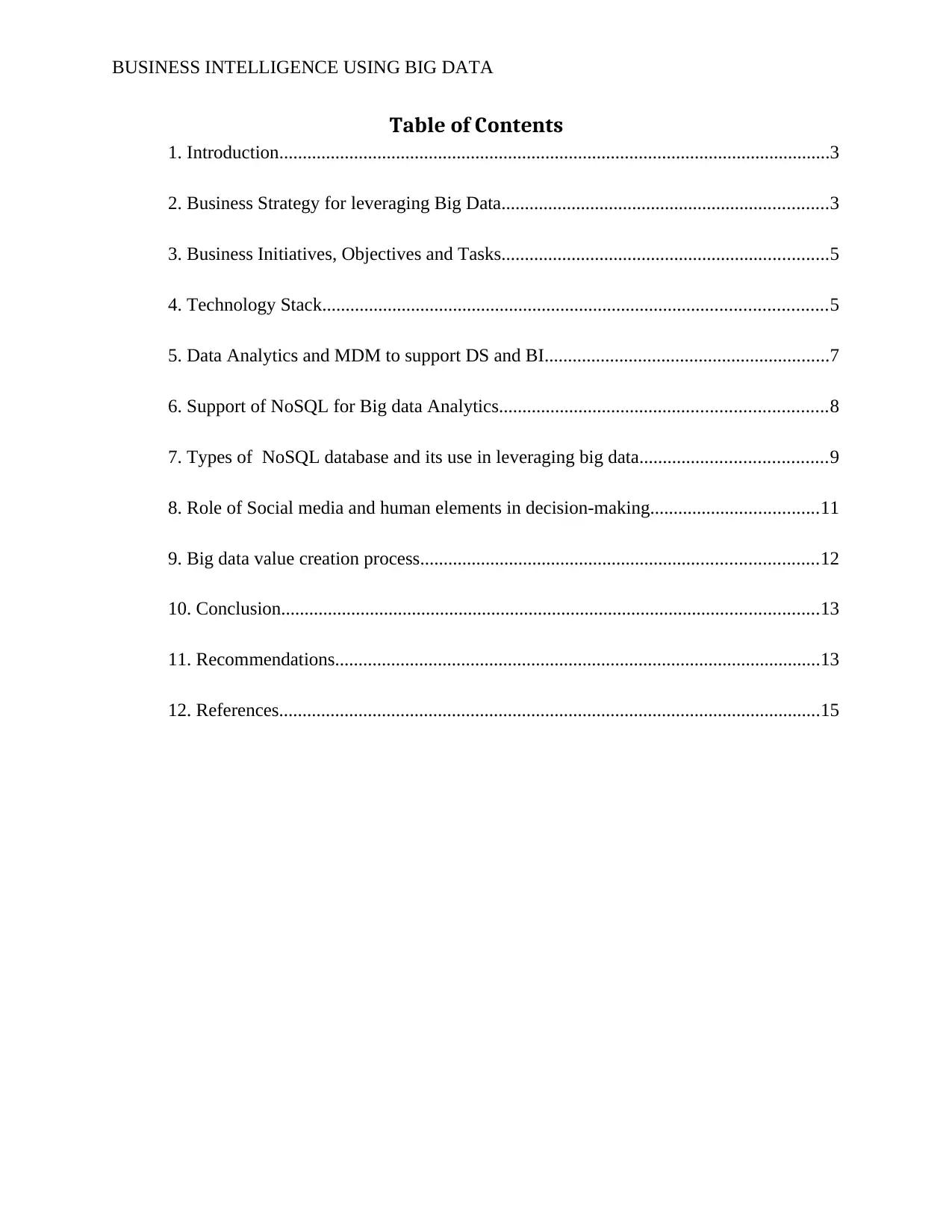
BUSINESS INTELLIGENCE USING BIG DATA
Table of Contents
1. Introduction......................................................................................................................3
2. Business Strategy for leveraging Big Data......................................................................3
3. Business Initiatives, Objectives and Tasks......................................................................5
4. Technology Stack............................................................................................................5
5. Data Analytics and MDM to support DS and BI.............................................................7
6. Support of NoSQL for Big data Analytics......................................................................8
7. Types of NoSQL database and its use in leveraging big data........................................9
8. Role of Social media and human elements in decision-making....................................11
9. Big data value creation process.....................................................................................12
10. Conclusion...................................................................................................................13
11. Recommendations........................................................................................................13
12. References....................................................................................................................15
Table of Contents
1. Introduction......................................................................................................................3
2. Business Strategy for leveraging Big Data......................................................................3
3. Business Initiatives, Objectives and Tasks......................................................................5
4. Technology Stack............................................................................................................5
5. Data Analytics and MDM to support DS and BI.............................................................7
6. Support of NoSQL for Big data Analytics......................................................................8
7. Types of NoSQL database and its use in leveraging big data........................................9
8. Role of Social media and human elements in decision-making....................................11
9. Big data value creation process.....................................................................................12
10. Conclusion...................................................................................................................13
11. Recommendations........................................................................................................13
12. References....................................................................................................................15
⊘ This is a preview!⊘
Do you want full access?
Subscribe today to unlock all pages.

Trusted by 1+ million students worldwide
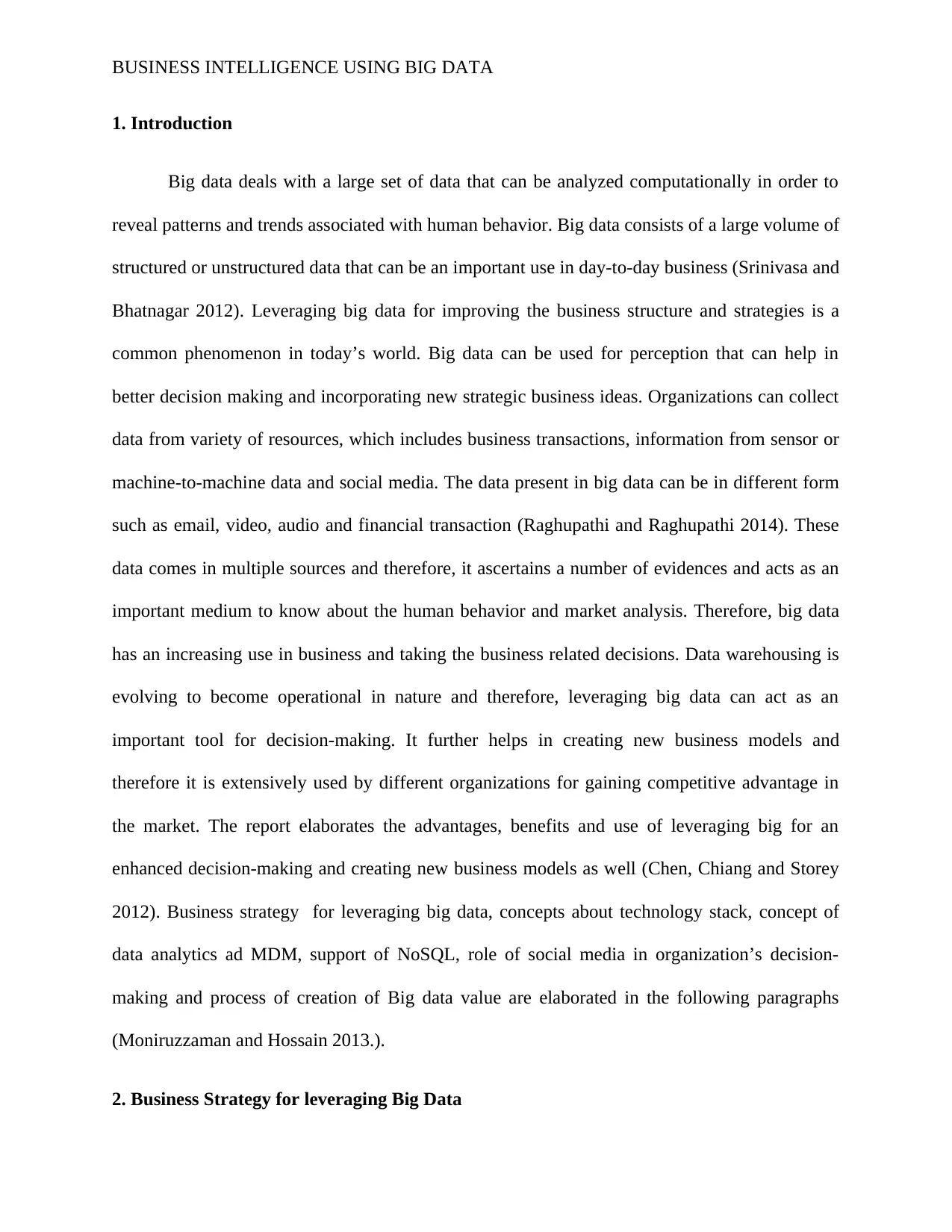
BUSINESS INTELLIGENCE USING BIG DATA
1. Introduction
Big data deals with a large set of data that can be analyzed computationally in order to
reveal patterns and trends associated with human behavior. Big data consists of a large volume of
structured or unstructured data that can be an important use in day-to-day business (Srinivasa and
Bhatnagar 2012). Leveraging big data for improving the business structure and strategies is a
common phenomenon in today’s world. Big data can be used for perception that can help in
better decision making and incorporating new strategic business ideas. Organizations can collect
data from variety of resources, which includes business transactions, information from sensor or
machine-to-machine data and social media. The data present in big data can be in different form
such as email, video, audio and financial transaction (Raghupathi and Raghupathi 2014). These
data comes in multiple sources and therefore, it ascertains a number of evidences and acts as an
important medium to know about the human behavior and market analysis. Therefore, big data
has an increasing use in business and taking the business related decisions. Data warehousing is
evolving to become operational in nature and therefore, leveraging big data can act as an
important tool for decision-making. It further helps in creating new business models and
therefore it is extensively used by different organizations for gaining competitive advantage in
the market. The report elaborates the advantages, benefits and use of leveraging big for an
enhanced decision-making and creating new business models as well (Chen, Chiang and Storey
2012). Business strategy for leveraging big data, concepts about technology stack, concept of
data analytics ad MDM, support of NoSQL, role of social media in organization’s decision-
making and process of creation of Big data value are elaborated in the following paragraphs
(Moniruzzaman and Hossain 2013.).
2. Business Strategy for leveraging Big Data
1. Introduction
Big data deals with a large set of data that can be analyzed computationally in order to
reveal patterns and trends associated with human behavior. Big data consists of a large volume of
structured or unstructured data that can be an important use in day-to-day business (Srinivasa and
Bhatnagar 2012). Leveraging big data for improving the business structure and strategies is a
common phenomenon in today’s world. Big data can be used for perception that can help in
better decision making and incorporating new strategic business ideas. Organizations can collect
data from variety of resources, which includes business transactions, information from sensor or
machine-to-machine data and social media. The data present in big data can be in different form
such as email, video, audio and financial transaction (Raghupathi and Raghupathi 2014). These
data comes in multiple sources and therefore, it ascertains a number of evidences and acts as an
important medium to know about the human behavior and market analysis. Therefore, big data
has an increasing use in business and taking the business related decisions. Data warehousing is
evolving to become operational in nature and therefore, leveraging big data can act as an
important tool for decision-making. It further helps in creating new business models and
therefore it is extensively used by different organizations for gaining competitive advantage in
the market. The report elaborates the advantages, benefits and use of leveraging big for an
enhanced decision-making and creating new business models as well (Chen, Chiang and Storey
2012). Business strategy for leveraging big data, concepts about technology stack, concept of
data analytics ad MDM, support of NoSQL, role of social media in organization’s decision-
making and process of creation of Big data value are elaborated in the following paragraphs
(Moniruzzaman and Hossain 2013.).
2. Business Strategy for leveraging Big Data
Paraphrase This Document
Need a fresh take? Get an instant paraphrase of this document with our AI Paraphraser
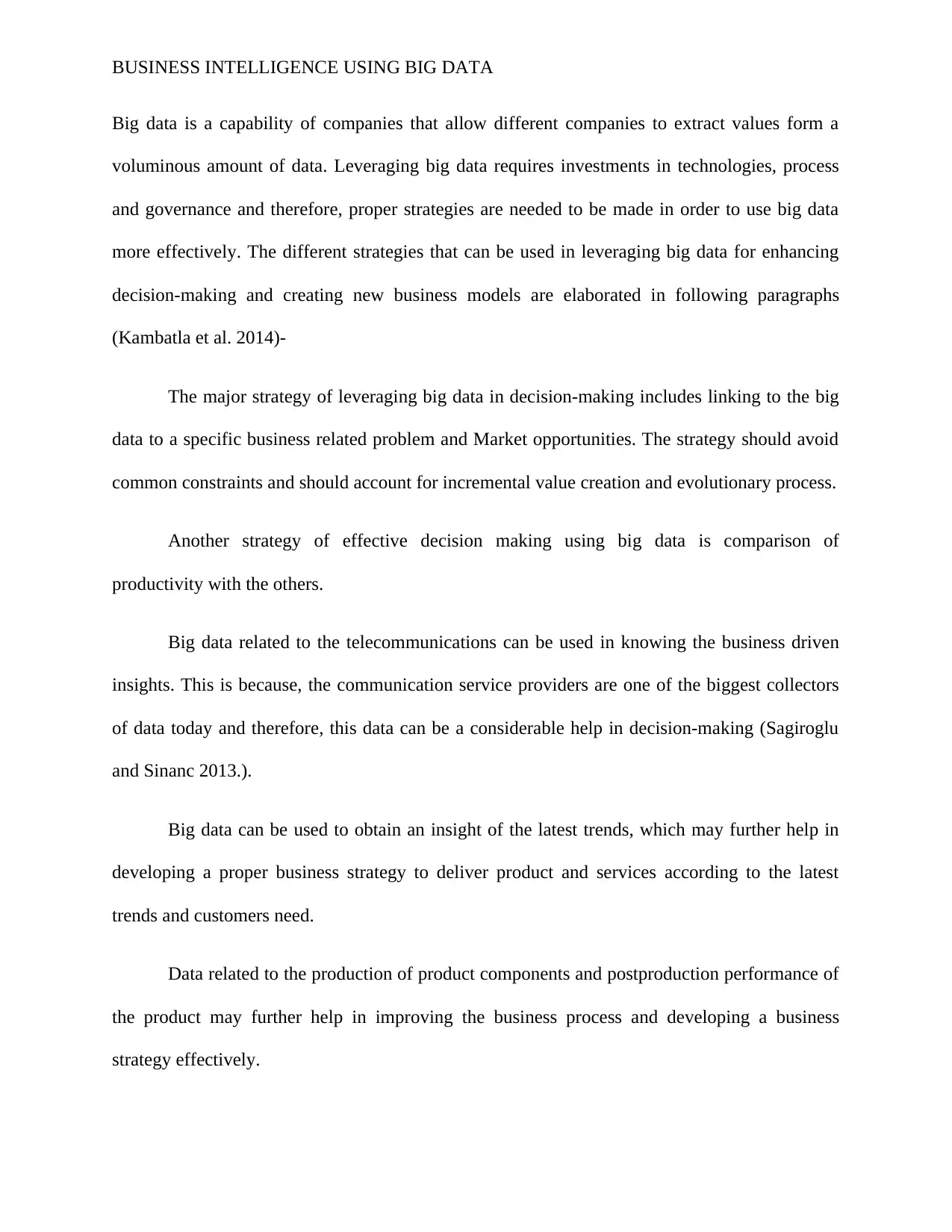
BUSINESS INTELLIGENCE USING BIG DATA
Big data is a capability of companies that allow different companies to extract values form a
voluminous amount of data. Leveraging big data requires investments in technologies, process
and governance and therefore, proper strategies are needed to be made in order to use big data
more effectively. The different strategies that can be used in leveraging big data for enhancing
decision-making and creating new business models are elaborated in following paragraphs
(Kambatla et al. 2014)-
The major strategy of leveraging big data in decision-making includes linking to the big
data to a specific business related problem and Market opportunities. The strategy should avoid
common constraints and should account for incremental value creation and evolutionary process.
Another strategy of effective decision making using big data is comparison of
productivity with the others.
Big data related to the telecommunications can be used in knowing the business driven
insights. This is because, the communication service providers are one of the biggest collectors
of data today and therefore, this data can be a considerable help in decision-making (Sagiroglu
and Sinanc 2013.).
Big data can be used to obtain an insight of the latest trends, which may further help in
developing a proper business strategy to deliver product and services according to the latest
trends and customers need.
Data related to the production of product components and postproduction performance of
the product may further help in improving the business process and developing a business
strategy effectively.
Big data is a capability of companies that allow different companies to extract values form a
voluminous amount of data. Leveraging big data requires investments in technologies, process
and governance and therefore, proper strategies are needed to be made in order to use big data
more effectively. The different strategies that can be used in leveraging big data for enhancing
decision-making and creating new business models are elaborated in following paragraphs
(Kambatla et al. 2014)-
The major strategy of leveraging big data in decision-making includes linking to the big
data to a specific business related problem and Market opportunities. The strategy should avoid
common constraints and should account for incremental value creation and evolutionary process.
Another strategy of effective decision making using big data is comparison of
productivity with the others.
Big data related to the telecommunications can be used in knowing the business driven
insights. This is because, the communication service providers are one of the biggest collectors
of data today and therefore, this data can be a considerable help in decision-making (Sagiroglu
and Sinanc 2013.).
Big data can be used to obtain an insight of the latest trends, which may further help in
developing a proper business strategy to deliver product and services according to the latest
trends and customers need.
Data related to the production of product components and postproduction performance of
the product may further help in improving the business process and developing a business
strategy effectively.
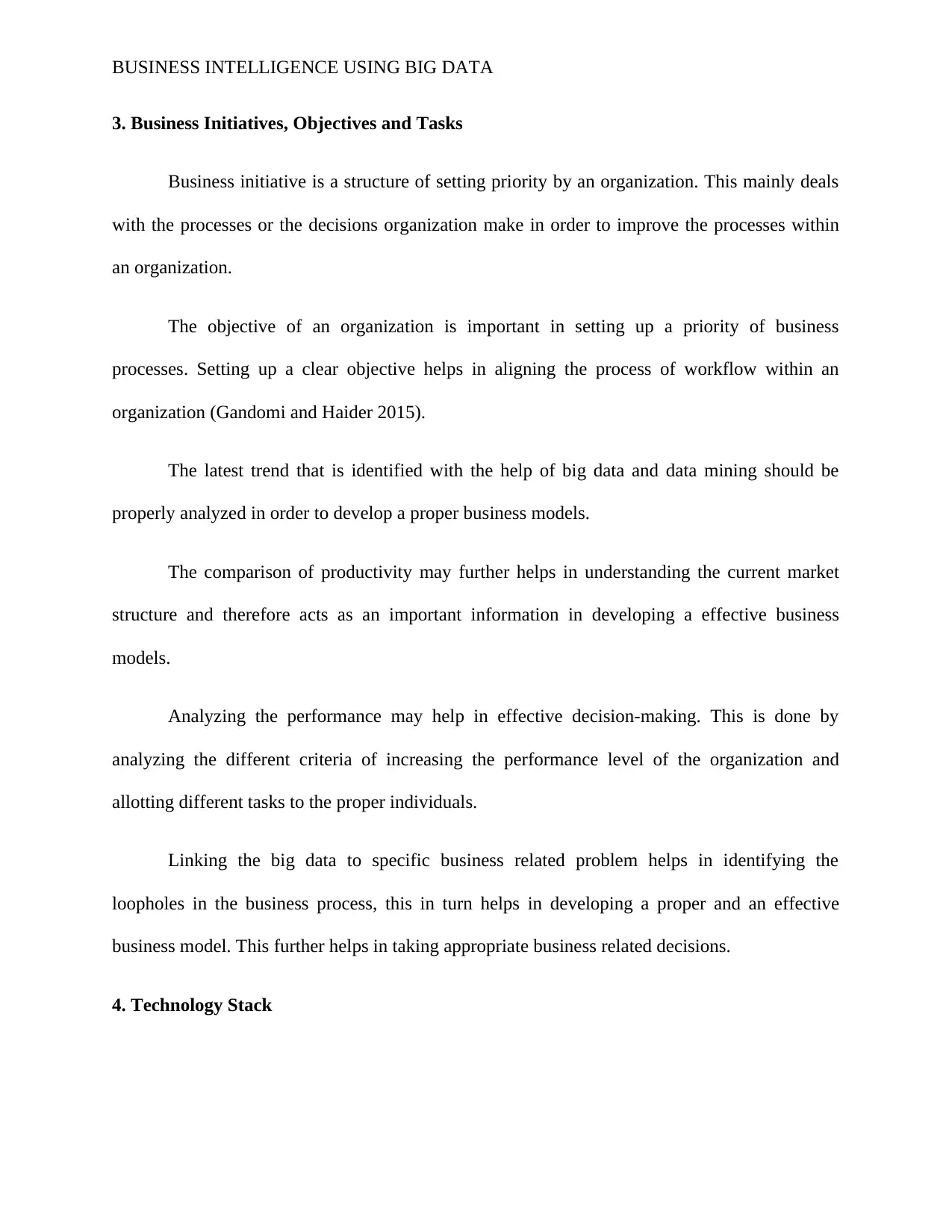
BUSINESS INTELLIGENCE USING BIG DATA
3. Business Initiatives, Objectives and Tasks
Business initiative is a structure of setting priority by an organization. This mainly deals
with the processes or the decisions organization make in order to improve the processes within
an organization.
The objective of an organization is important in setting up a priority of business
processes. Setting up a clear objective helps in aligning the process of workflow within an
organization (Gandomi and Haider 2015).
The latest trend that is identified with the help of big data and data mining should be
properly analyzed in order to develop a proper business models.
The comparison of productivity may further helps in understanding the current market
structure and therefore acts as an important information in developing a effective business
models.
Analyzing the performance may help in effective decision-making. This is done by
analyzing the different criteria of increasing the performance level of the organization and
allotting different tasks to the proper individuals.
Linking the big data to specific business related problem helps in identifying the
loopholes in the business process, this in turn helps in developing a proper and an effective
business model. This further helps in taking appropriate business related decisions.
4. Technology Stack
3. Business Initiatives, Objectives and Tasks
Business initiative is a structure of setting priority by an organization. This mainly deals
with the processes or the decisions organization make in order to improve the processes within
an organization.
The objective of an organization is important in setting up a priority of business
processes. Setting up a clear objective helps in aligning the process of workflow within an
organization (Gandomi and Haider 2015).
The latest trend that is identified with the help of big data and data mining should be
properly analyzed in order to develop a proper business models.
The comparison of productivity may further helps in understanding the current market
structure and therefore acts as an important information in developing a effective business
models.
Analyzing the performance may help in effective decision-making. This is done by
analyzing the different criteria of increasing the performance level of the organization and
allotting different tasks to the proper individuals.
Linking the big data to specific business related problem helps in identifying the
loopholes in the business process, this in turn helps in developing a proper and an effective
business model. This further helps in taking appropriate business related decisions.
4. Technology Stack
⊘ This is a preview!⊘
Do you want full access?
Subscribe today to unlock all pages.

Trusted by 1+ million students worldwide
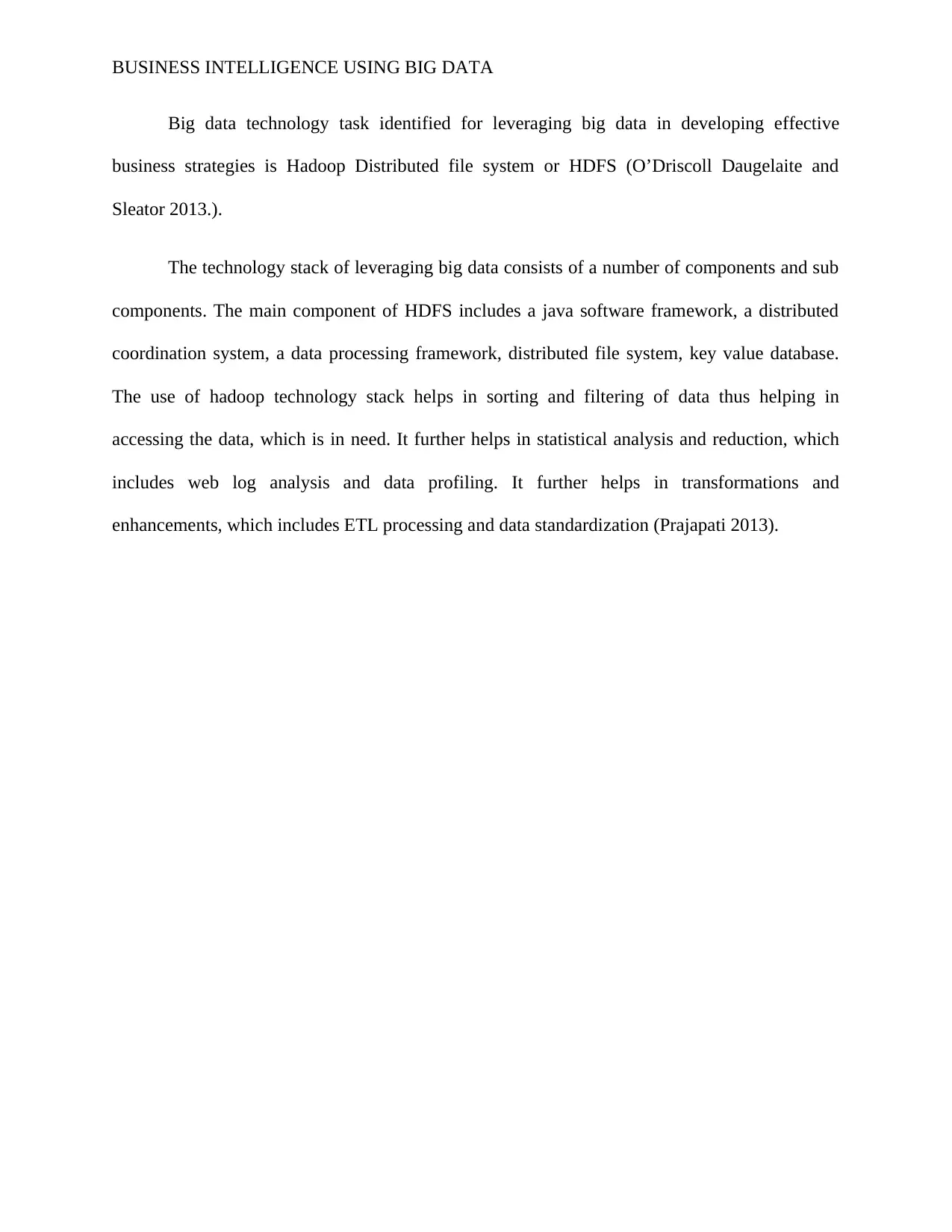
BUSINESS INTELLIGENCE USING BIG DATA
Big data technology task identified for leveraging big data in developing effective
business strategies is Hadoop Distributed file system or HDFS (O’Driscoll Daugelaite and
Sleator 2013.).
The technology stack of leveraging big data consists of a number of components and sub
components. The main component of HDFS includes a java software framework, a distributed
coordination system, a data processing framework, distributed file system, key value database.
The use of hadoop technology stack helps in sorting and filtering of data thus helping in
accessing the data, which is in need. It further helps in statistical analysis and reduction, which
includes web log analysis and data profiling. It further helps in transformations and
enhancements, which includes ETL processing and data standardization (Prajapati 2013).
Big data technology task identified for leveraging big data in developing effective
business strategies is Hadoop Distributed file system or HDFS (O’Driscoll Daugelaite and
Sleator 2013.).
The technology stack of leveraging big data consists of a number of components and sub
components. The main component of HDFS includes a java software framework, a distributed
coordination system, a data processing framework, distributed file system, key value database.
The use of hadoop technology stack helps in sorting and filtering of data thus helping in
accessing the data, which is in need. It further helps in statistical analysis and reduction, which
includes web log analysis and data profiling. It further helps in transformations and
enhancements, which includes ETL processing and data standardization (Prajapati 2013).
Paraphrase This Document
Need a fresh take? Get an instant paraphrase of this document with our AI Paraphraser
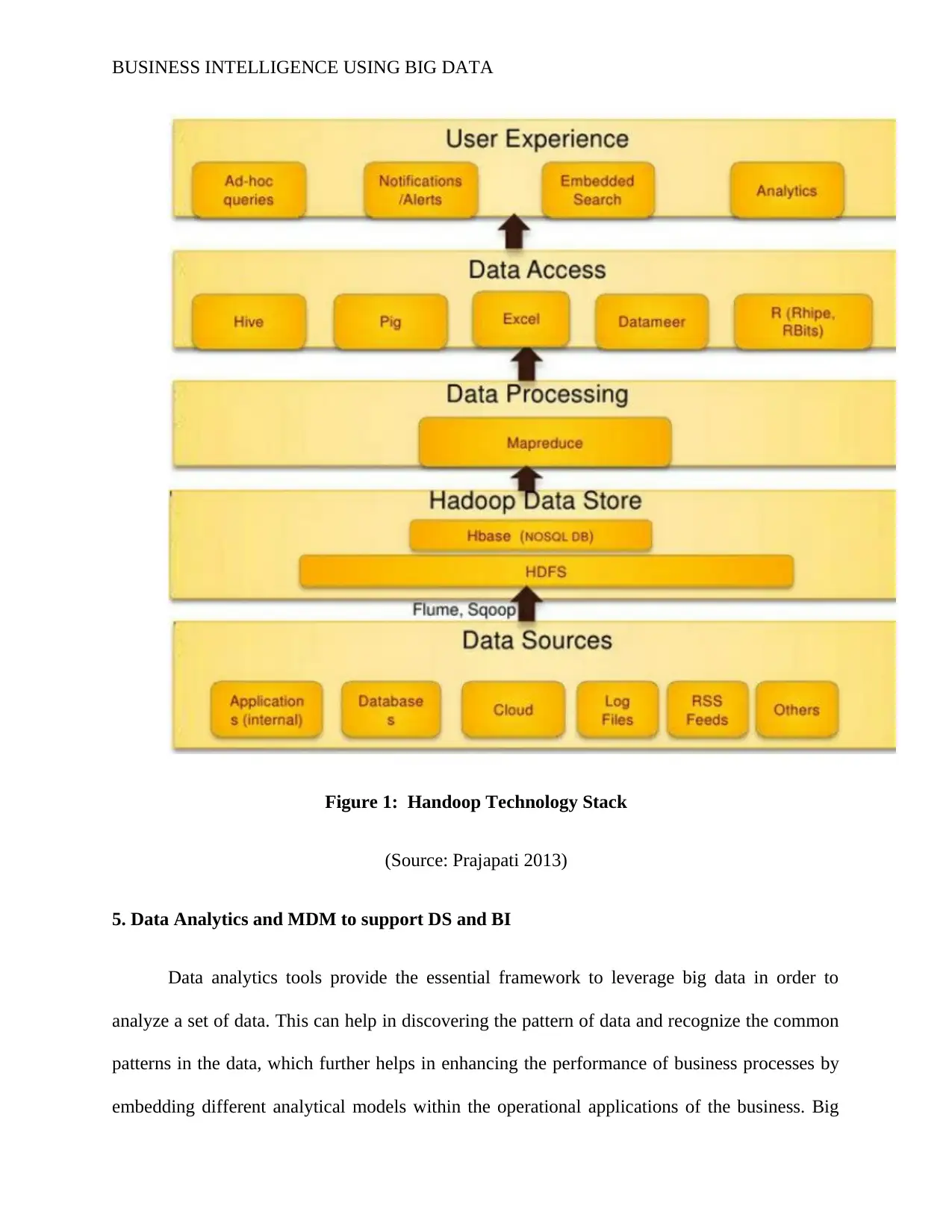
BUSINESS INTELLIGENCE USING BIG DATA
Figure 1: Handoop Technology Stack
(Source: Prajapati 2013)
5. Data Analytics and MDM to support DS and BI
Data analytics tools provide the essential framework to leverage big data in order to
analyze a set of data. This can help in discovering the pattern of data and recognize the common
patterns in the data, which further helps in enhancing the performance of business processes by
embedding different analytical models within the operational applications of the business. Big
Figure 1: Handoop Technology Stack
(Source: Prajapati 2013)
5. Data Analytics and MDM to support DS and BI
Data analytics tools provide the essential framework to leverage big data in order to
analyze a set of data. This can help in discovering the pattern of data and recognize the common
patterns in the data, which further helps in enhancing the performance of business processes by
embedding different analytical models within the operational applications of the business. Big
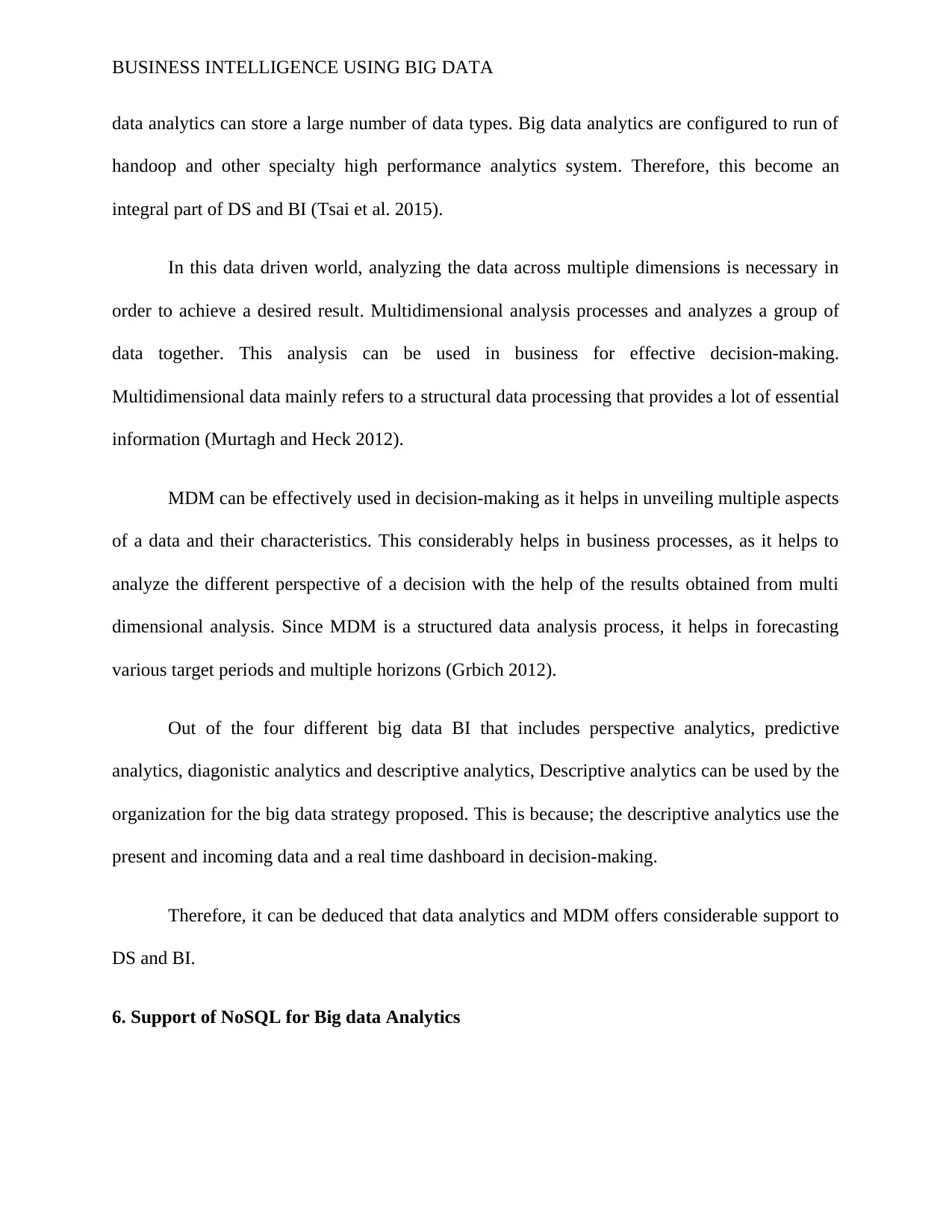
BUSINESS INTELLIGENCE USING BIG DATA
data analytics can store a large number of data types. Big data analytics are configured to run of
handoop and other specialty high performance analytics system. Therefore, this become an
integral part of DS and BI (Tsai et al. 2015).
In this data driven world, analyzing the data across multiple dimensions is necessary in
order to achieve a desired result. Multidimensional analysis processes and analyzes a group of
data together. This analysis can be used in business for effective decision-making.
Multidimensional data mainly refers to a structural data processing that provides a lot of essential
information (Murtagh and Heck 2012).
MDM can be effectively used in decision-making as it helps in unveiling multiple aspects
of a data and their characteristics. This considerably helps in business processes, as it helps to
analyze the different perspective of a decision with the help of the results obtained from multi
dimensional analysis. Since MDM is a structured data analysis process, it helps in forecasting
various target periods and multiple horizons (Grbich 2012).
Out of the four different big data BI that includes perspective analytics, predictive
analytics, diagonistic analytics and descriptive analytics, Descriptive analytics can be used by the
organization for the big data strategy proposed. This is because; the descriptive analytics use the
present and incoming data and a real time dashboard in decision-making.
Therefore, it can be deduced that data analytics and MDM offers considerable support to
DS and BI.
6. Support of NoSQL for Big data Analytics
data analytics can store a large number of data types. Big data analytics are configured to run of
handoop and other specialty high performance analytics system. Therefore, this become an
integral part of DS and BI (Tsai et al. 2015).
In this data driven world, analyzing the data across multiple dimensions is necessary in
order to achieve a desired result. Multidimensional analysis processes and analyzes a group of
data together. This analysis can be used in business for effective decision-making.
Multidimensional data mainly refers to a structural data processing that provides a lot of essential
information (Murtagh and Heck 2012).
MDM can be effectively used in decision-making as it helps in unveiling multiple aspects
of a data and their characteristics. This considerably helps in business processes, as it helps to
analyze the different perspective of a decision with the help of the results obtained from multi
dimensional analysis. Since MDM is a structured data analysis process, it helps in forecasting
various target periods and multiple horizons (Grbich 2012).
Out of the four different big data BI that includes perspective analytics, predictive
analytics, diagonistic analytics and descriptive analytics, Descriptive analytics can be used by the
organization for the big data strategy proposed. This is because; the descriptive analytics use the
present and incoming data and a real time dashboard in decision-making.
Therefore, it can be deduced that data analytics and MDM offers considerable support to
DS and BI.
6. Support of NoSQL for Big data Analytics
⊘ This is a preview!⊘
Do you want full access?
Subscribe today to unlock all pages.

Trusted by 1+ million students worldwide
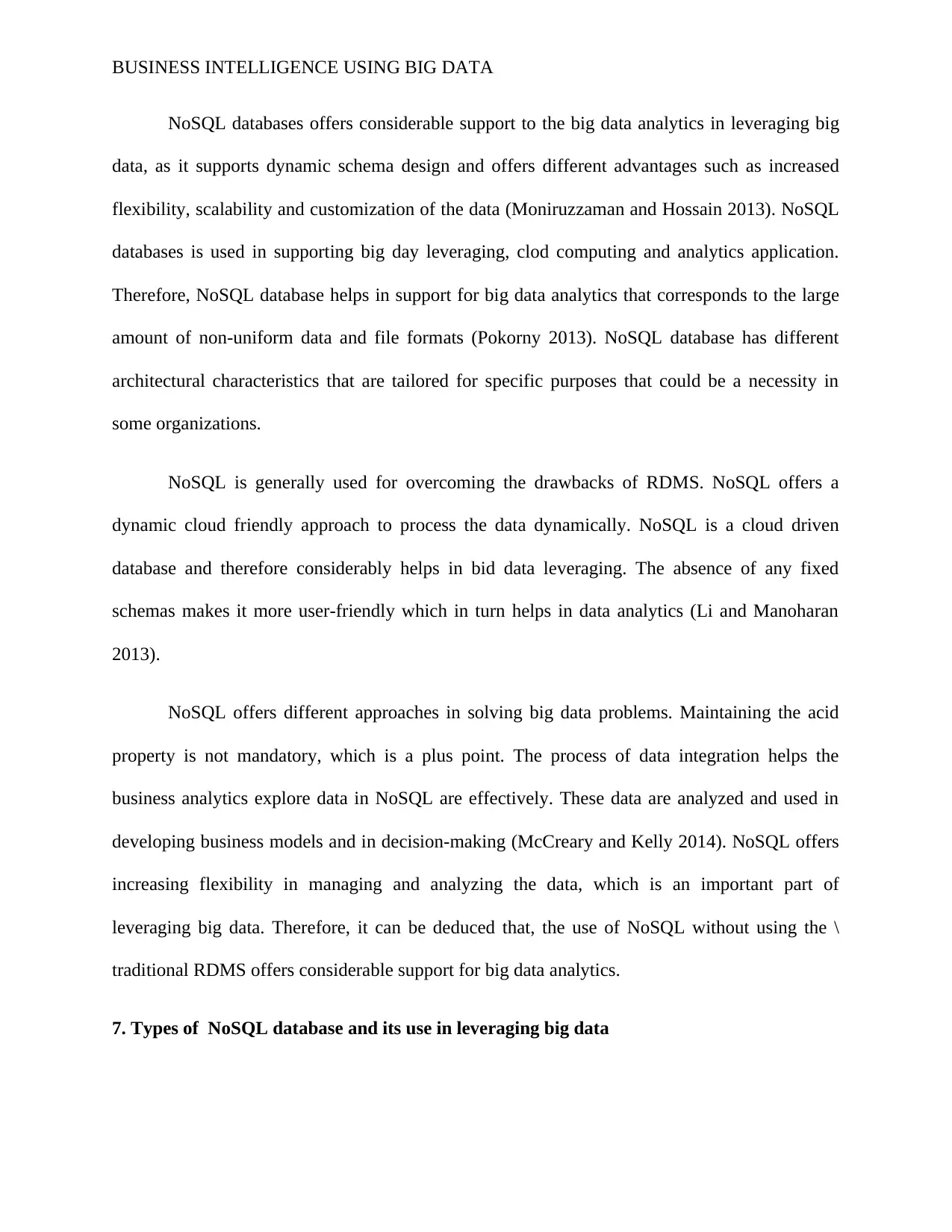
BUSINESS INTELLIGENCE USING BIG DATA
NoSQL databases offers considerable support to the big data analytics in leveraging big
data, as it supports dynamic schema design and offers different advantages such as increased
flexibility, scalability and customization of the data (Moniruzzaman and Hossain 2013). NoSQL
databases is used in supporting big day leveraging, clod computing and analytics application.
Therefore, NoSQL database helps in support for big data analytics that corresponds to the large
amount of non-uniform data and file formats (Pokorny 2013). NoSQL database has different
architectural characteristics that are tailored for specific purposes that could be a necessity in
some organizations.
NoSQL is generally used for overcoming the drawbacks of RDMS. NoSQL offers a
dynamic cloud friendly approach to process the data dynamically. NoSQL is a cloud driven
database and therefore considerably helps in bid data leveraging. The absence of any fixed
schemas makes it more user-friendly which in turn helps in data analytics (Li and Manoharan
2013).
NoSQL offers different approaches in solving big data problems. Maintaining the acid
property is not mandatory, which is a plus point. The process of data integration helps the
business analytics explore data in NoSQL are effectively. These data are analyzed and used in
developing business models and in decision-making (McCreary and Kelly 2014). NoSQL offers
increasing flexibility in managing and analyzing the data, which is an important part of
leveraging big data. Therefore, it can be deduced that, the use of NoSQL without using the \
traditional RDMS offers considerable support for big data analytics.
7. Types of NoSQL database and its use in leveraging big data
NoSQL databases offers considerable support to the big data analytics in leveraging big
data, as it supports dynamic schema design and offers different advantages such as increased
flexibility, scalability and customization of the data (Moniruzzaman and Hossain 2013). NoSQL
databases is used in supporting big day leveraging, clod computing and analytics application.
Therefore, NoSQL database helps in support for big data analytics that corresponds to the large
amount of non-uniform data and file formats (Pokorny 2013). NoSQL database has different
architectural characteristics that are tailored for specific purposes that could be a necessity in
some organizations.
NoSQL is generally used for overcoming the drawbacks of RDMS. NoSQL offers a
dynamic cloud friendly approach to process the data dynamically. NoSQL is a cloud driven
database and therefore considerably helps in bid data leveraging. The absence of any fixed
schemas makes it more user-friendly which in turn helps in data analytics (Li and Manoharan
2013).
NoSQL offers different approaches in solving big data problems. Maintaining the acid
property is not mandatory, which is a plus point. The process of data integration helps the
business analytics explore data in NoSQL are effectively. These data are analyzed and used in
developing business models and in decision-making (McCreary and Kelly 2014). NoSQL offers
increasing flexibility in managing and analyzing the data, which is an important part of
leveraging big data. Therefore, it can be deduced that, the use of NoSQL without using the \
traditional RDMS offers considerable support for big data analytics.
7. Types of NoSQL database and its use in leveraging big data
Paraphrase This Document
Need a fresh take? Get an instant paraphrase of this document with our AI Paraphraser
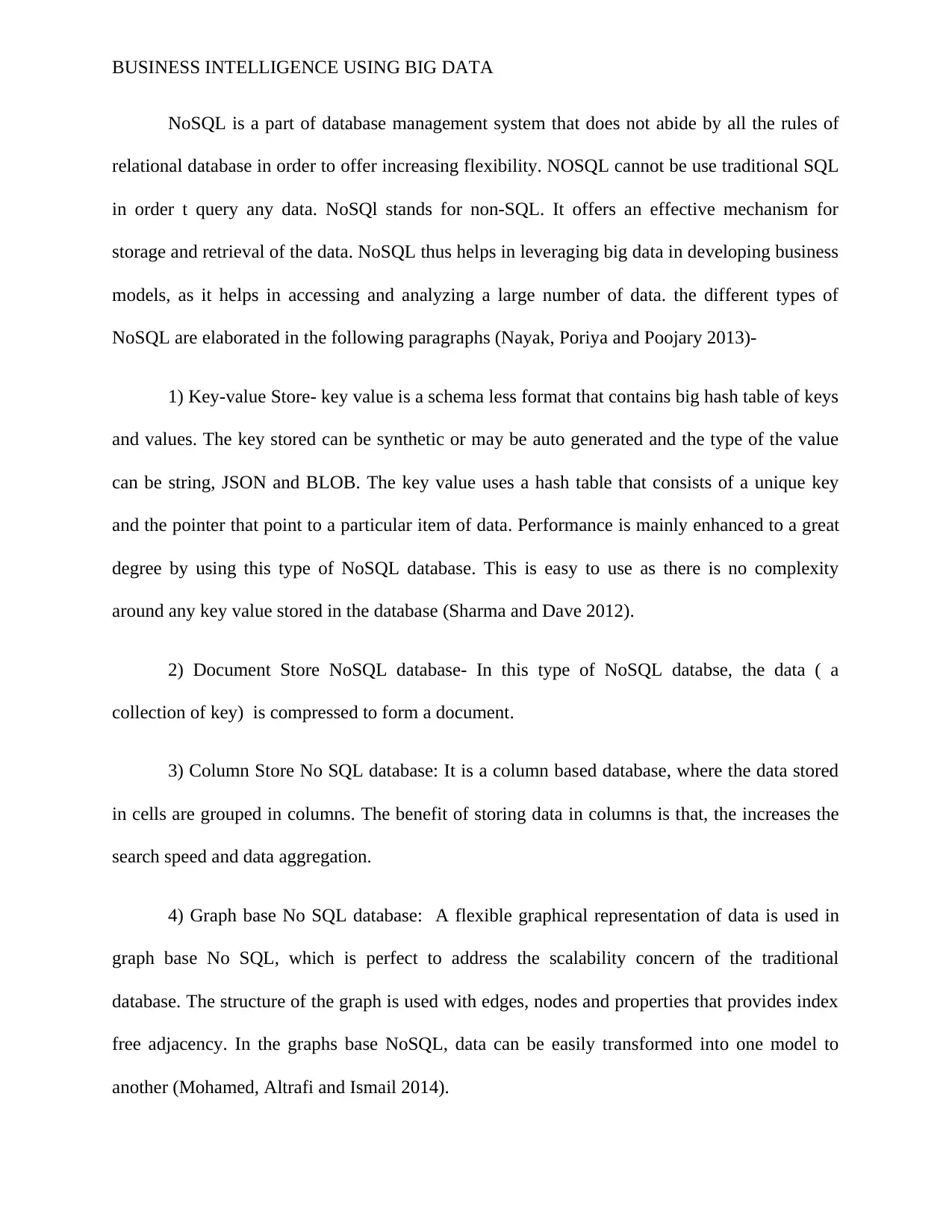
BUSINESS INTELLIGENCE USING BIG DATA
NoSQL is a part of database management system that does not abide by all the rules of
relational database in order to offer increasing flexibility. NOSQL cannot be use traditional SQL
in order t query any data. NoSQl stands for non-SQL. It offers an effective mechanism for
storage and retrieval of the data. NoSQL thus helps in leveraging big data in developing business
models, as it helps in accessing and analyzing a large number of data. the different types of
NoSQL are elaborated in the following paragraphs (Nayak, Poriya and Poojary 2013)-
1) Key-value Store- key value is a schema less format that contains big hash table of keys
and values. The key stored can be synthetic or may be auto generated and the type of the value
can be string, JSON and BLOB. The key value uses a hash table that consists of a unique key
and the pointer that point to a particular item of data. Performance is mainly enhanced to a great
degree by using this type of NoSQL database. This is easy to use as there is no complexity
around any key value stored in the database (Sharma and Dave 2012).
2) Document Store NoSQL database- In this type of NoSQL databse, the data ( a
collection of key) is compressed to form a document.
3) Column Store No SQL database: It is a column based database, where the data stored
in cells are grouped in columns. The benefit of storing data in columns is that, the increases the
search speed and data aggregation.
4) Graph base No SQL database: A flexible graphical representation of data is used in
graph base No SQL, which is perfect to address the scalability concern of the traditional
database. The structure of the graph is used with edges, nodes and properties that provides index
free adjacency. In the graphs base NoSQL, data can be easily transformed into one model to
another (Mohamed, Altrafi and Ismail 2014).
NoSQL is a part of database management system that does not abide by all the rules of
relational database in order to offer increasing flexibility. NOSQL cannot be use traditional SQL
in order t query any data. NoSQl stands for non-SQL. It offers an effective mechanism for
storage and retrieval of the data. NoSQL thus helps in leveraging big data in developing business
models, as it helps in accessing and analyzing a large number of data. the different types of
NoSQL are elaborated in the following paragraphs (Nayak, Poriya and Poojary 2013)-
1) Key-value Store- key value is a schema less format that contains big hash table of keys
and values. The key stored can be synthetic or may be auto generated and the type of the value
can be string, JSON and BLOB. The key value uses a hash table that consists of a unique key
and the pointer that point to a particular item of data. Performance is mainly enhanced to a great
degree by using this type of NoSQL database. This is easy to use as there is no complexity
around any key value stored in the database (Sharma and Dave 2012).
2) Document Store NoSQL database- In this type of NoSQL databse, the data ( a
collection of key) is compressed to form a document.
3) Column Store No SQL database: It is a column based database, where the data stored
in cells are grouped in columns. The benefit of storing data in columns is that, the increases the
search speed and data aggregation.
4) Graph base No SQL database: A flexible graphical representation of data is used in
graph base No SQL, which is perfect to address the scalability concern of the traditional
database. The structure of the graph is used with edges, nodes and properties that provides index
free adjacency. In the graphs base NoSQL, data can be easily transformed into one model to
another (Mohamed, Altrafi and Ismail 2014).
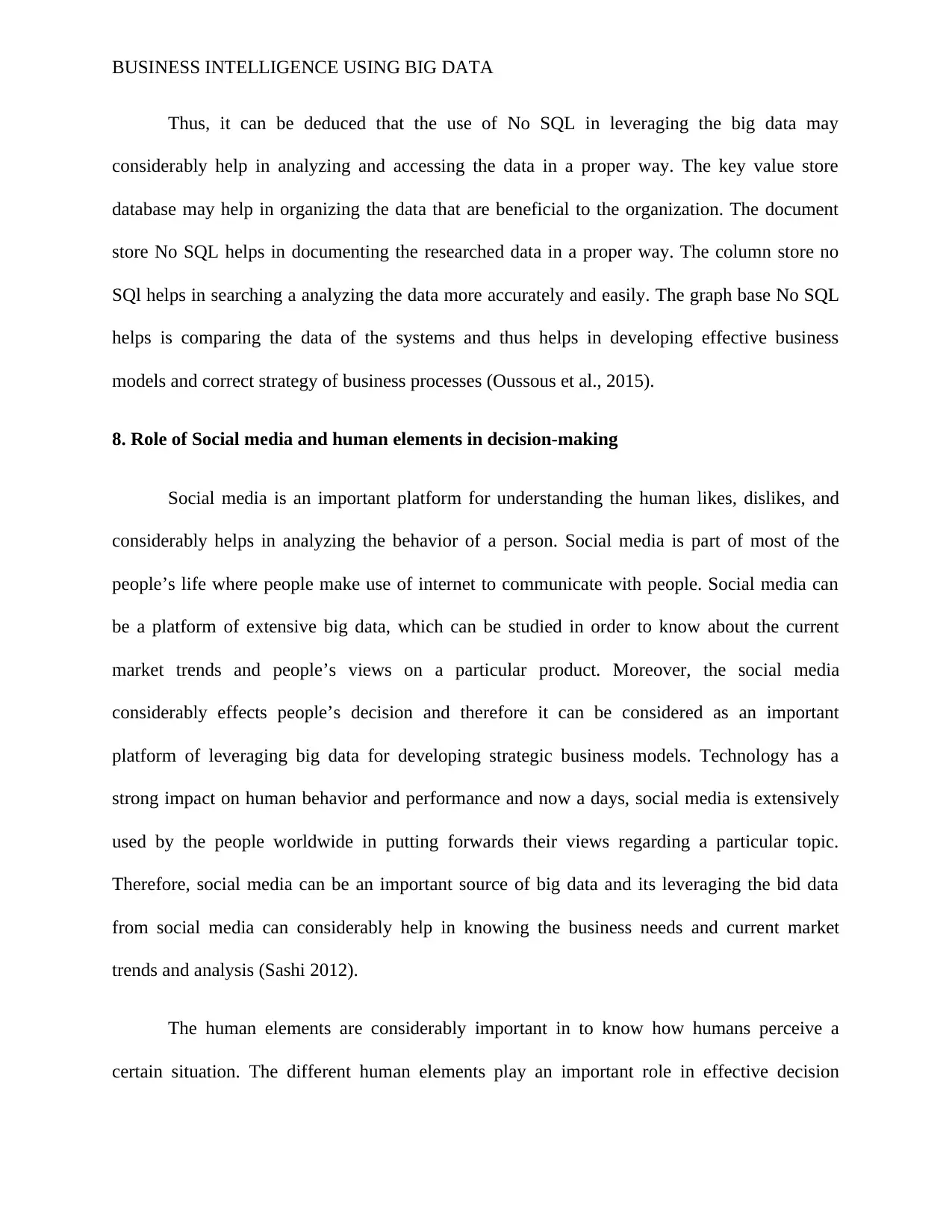
BUSINESS INTELLIGENCE USING BIG DATA
Thus, it can be deduced that the use of No SQL in leveraging the big data may
considerably help in analyzing and accessing the data in a proper way. The key value store
database may help in organizing the data that are beneficial to the organization. The document
store No SQL helps in documenting the researched data in a proper way. The column store no
SQl helps in searching a analyzing the data more accurately and easily. The graph base No SQL
helps is comparing the data of the systems and thus helps in developing effective business
models and correct strategy of business processes (Oussous et al., 2015).
8. Role of Social media and human elements in decision-making
Social media is an important platform for understanding the human likes, dislikes, and
considerably helps in analyzing the behavior of a person. Social media is part of most of the
people’s life where people make use of internet to communicate with people. Social media can
be a platform of extensive big data, which can be studied in order to know about the current
market trends and people’s views on a particular product. Moreover, the social media
considerably effects people’s decision and therefore it can be considered as an important
platform of leveraging big data for developing strategic business models. Technology has a
strong impact on human behavior and performance and now a days, social media is extensively
used by the people worldwide in putting forwards their views regarding a particular topic.
Therefore, social media can be an important source of big data and its leveraging the bid data
from social media can considerably help in knowing the business needs and current market
trends and analysis (Sashi 2012).
The human elements are considerably important in to know how humans perceive a
certain situation. The different human elements play an important role in effective decision
Thus, it can be deduced that the use of No SQL in leveraging the big data may
considerably help in analyzing and accessing the data in a proper way. The key value store
database may help in organizing the data that are beneficial to the organization. The document
store No SQL helps in documenting the researched data in a proper way. The column store no
SQl helps in searching a analyzing the data more accurately and easily. The graph base No SQL
helps is comparing the data of the systems and thus helps in developing effective business
models and correct strategy of business processes (Oussous et al., 2015).
8. Role of Social media and human elements in decision-making
Social media is an important platform for understanding the human likes, dislikes, and
considerably helps in analyzing the behavior of a person. Social media is part of most of the
people’s life where people make use of internet to communicate with people. Social media can
be a platform of extensive big data, which can be studied in order to know about the current
market trends and people’s views on a particular product. Moreover, the social media
considerably effects people’s decision and therefore it can be considered as an important
platform of leveraging big data for developing strategic business models. Technology has a
strong impact on human behavior and performance and now a days, social media is extensively
used by the people worldwide in putting forwards their views regarding a particular topic.
Therefore, social media can be an important source of big data and its leveraging the bid data
from social media can considerably help in knowing the business needs and current market
trends and analysis (Sashi 2012).
The human elements are considerably important in to know how humans perceive a
certain situation. The different human elements play an important role in effective decision
⊘ This is a preview!⊘
Do you want full access?
Subscribe today to unlock all pages.

Trusted by 1+ million students worldwide
1 out of 18
Related Documents
Your All-in-One AI-Powered Toolkit for Academic Success.
+13062052269
info@desklib.com
Available 24*7 on WhatsApp / Email
![[object Object]](/_next/static/media/star-bottom.7253800d.svg)
Unlock your academic potential
Copyright © 2020–2025 A2Z Services. All Rights Reserved. Developed and managed by ZUCOL.




